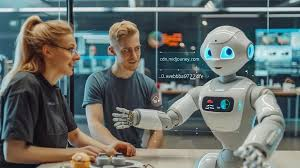Industrial cobots are collaborative robots designed to work safely alongside human operators, helping manufacturers reduce production costs while improving efficiency and quality. Unlike traditional industrial robots, these cobots are flexible, easy to program, and ideal for handling repetitive or hazardous tasks without replacing human workers.
This article explores what industrial cobots are, how they function, and how they can help modern manufacturers save time and money.
What Are Industrial Cobots?
Industrial cobots, or collaborative robots, are designed to work safely alongside human operators in shared workspaces. Unlike traditional industrial robots, which often require safety barriers and operate independently, cobots are made for direct interaction with humans, improving both productivity and safety in industrial settings.
How Industrial Cobots Work
Industrial cobots are built to work safely and efficiently alongside humans by combining advanced technology, flexible programming, and precise task execution.
1. Safety Technology
- Cobots use sensors, cameras, and force-limiting systems to detect human presence and prevent accidents.
- They can slow down or stop automatically when someone gets too close, allowing safe collaboration without safety cages.
2. Programming Methods
Cobots can be programmed in several user-friendly ways:
- Hand-guiding: Operators physically guide the cobot through a task, and it learns to repeat it.
- Teach pendants: A control device allows users to input movements and instructions.
- Intuitive interfaces: Drag-and-drop software and learning modes make programming accessible even for beginners.
3. Task Handling
- Cobots efficiently perform repetitive, dangerous, or precise tasks with consistent accuracy and without fatigue.
Industrial cobots are safe to work with, adaptable to different tasks, and perform work accurately. This helps businesses produce more, make fewer mistakes, and maintain a safer workplace.
Ways Industrial Cobots Reduce Production Costs
Industrial collaborative robots (cobots) are changing manufacturing by boosting efficiency, improving product quality, reducing costs, and enhancing workplace safety.
1. Boosting Efficiency and Productivity
- Operate continuously without fatigue, boosting output and accelerating production cycles.
- Handle repetitive tasks, freeing human workers for complex work.
- Accuracy and reliability minimize downtime, enhancing operational efficiency.
2. Improving Product Quality and Consistency
- Work accurately to produce consistent products.
- Sensors and cameras detect defects immediately, reducing waste and rework.
3. Reducing Labor and Operational Costs
- Handle repetitive tasks, reducing the need for manual labor.
- Easy to set up and program, simpler than traditional robots.
- Lower labor costs and higher productivity lead to faster ROI.
4. Enhancing Workplace Safety
- Handle dangerous tasks, keeping workers safe.
- Built-in safety features prevent accidents and help comply with safety regulations.
Cobots vs. Industrial Robots: Key Differences
| Feature | Cobots | Industrial Robots |
|---|---|---|
| Human Collaboration & Safety | Built to work safely alongside humans; no safety cages required | Usually operate in isolation with safety fences or cages |
| Flexibility & Deployment | Flexible and easily reprogrammable | Task-specific and less adaptable |
| Cost & ROI | Lower upfront cost, faster ROI, ideal for SMBs | Higher investment, longer ROI, suitable for stable, high-volume operations |
Cobots shine in human collaboration, flexibility, lower cost, and adaptability, making them perfect for small-scale or dynamic production where humans and robots work together.
Applications of Industrial Cobots
Industrial cobots are versatile robots that enhance productivity, precision, and safety across industries.
1. Machine Tending and Assembly
- Loading/unloading materials into machines (CNC, presses, injection molding).
- Perform precise assembly tasks for electronics, automotive parts, and medical devices.
2. Quality Inspection
- Equipped with cameras and sensors to inspect products, measure dimensions, and ensure accuracy.
- Ensures high-quality products, minimizes errors, and follows regulations.
3. Material Handling and Logistics
- Stack, unstack, package, sort, and move materials in factories or warehouses.
- Reduce worker fatigue and improve overall efficiency.
The Future of Industrial Cobots
The future of cobots involves deeper integration with AI, IoT, and Industry 4.0 systems.
1. AI and Machine Learning Integration
- Cobots analyze data, adapt to changing conditions, and make autonomous decisions.
- Improves task precision, product quality, and predictive maintenance.
2. Enhanced Human-Robot Collaboration
- Handle repetitive/dangerous tasks while humans focus on creative/problem-solving work.
- Increases productivity and fosters a harmonious work environment.
3. Cost Reduction and Productivity Gains
- Save on labor costs, minimize mistakes, and produce higher-quality products.
- Flexible and scalable for small and medium-sized businesses.
How to Get Started with Cobots
1. Identify Tasks for Automation
- Find repetitive, hazardous, or precision tasks suitable for cobots.
2. Consult a Cobot Solutions Provider
- Work with experts like Techman Robot to assess needs and select the right model.
3. Plan Integration and Training
- Map out cobot workflows and train staff on operation, programming, and safety.
4. Start Small and Scale Up
- Begin with a few cobots, monitor results, then expand gradually.
5. Leverage Automation Benefits
- Boost productivity, improve safety, reduce errors, and free humans for high-value tasks.
Industrial cobots are a cost-effective, safe, and flexible solution for modern manufacturing, helping businesses increase efficiency, maintain quality, and create safer work environments.
READ MORE : The Rise of the “Swiss Army Knife

